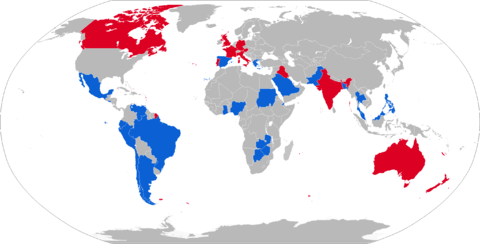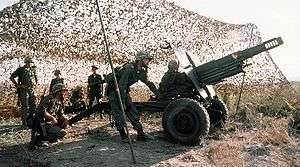OTO Melara Mod 56
| OTO Melara Model 56/14 pack howitzer | |
|---|---|
|
Spanish marines with OTO Melara Model 56/14 pack howitzer | |
| Type | Pack howitzer |
| Place of origin |
|
| Service history | |
| Used by | See Operators |
| Production history | |
| Designer | OTO-Melara |
| Specifications | |
| Weight | 1,800 kg (3,970 lb) |
| Length | 3.65 m (12 ft 0 in) |
| Barrel length | 1.47 m (4 ft 9.9 in) |
| Width | 1.5 m (4 ft 11.1 in) |
| Height | 1.9 m (6 ft 2.8 in) |
| Crew | 7 |
|
| |
| Calibre | 105 mm (4.13 in) |
| Breech | vertical sliding block |
| Recoil | hydro-pneumatic |
| Carriage | split trail |
| Elevation | -7° to +65° |
| Traverse | 56° |
| Rate of fire | 10 rounds/min |
| Muzzle velocity | 416.0 m/s (1,360 ft/s) |
| Maximum firing range | 10,000 m (10,900 yd) |
The OTO-Melara Mod 56 is an Italian-made 105 mm pack howitzer built and developed by OTO-Melara. It fires the standard US type M1 ammunition.
History
The OTO Melara 105 mm Mod 56 began life in the 1950s to meet the requirement for a modern light-weight howitzer that could be used by the Italian Army's Alpini brigades mountain artillery regiments. That it remained in service with those same units a full half century after the howitzer's introduction is a testament to the gun's quality. The Mod 56 has a number of unique characteristics for a weapon of its caliber, including the ability for its crew to manhandle the gun (due to its light weight), and the capability of being able to be used in the direct fire role. Being a pack howitzer, it is designed to be broken down into 12 parts, each of which can be easily transported.[1]
The capability of this weapon to be "knocked-down" allows the sections to be transported a number of ways although the original design was for mule-pack using special pack saddles. More often it is towed by a light vehicle such as a jeep or Land Rover, and with the shield removed it can be carried inside an M113 APC. However, its particular attraction to Western armies in the 1960s was that its light weight meant it could be lifted in one piece by helicopter, which made the gun popular with light artillery units in many countries as well as the more specialized mountain and airborne troops. Overall, the Mod 56 has served in more than 30 countries worldwide, of which a partial listing of the major operators is listed below.
As an added refinement to the gun's mass, the Mod 56 is built to be an artillery piece with a reputation of ease with which it can be assembled and then disassembled into twelve components within minutes. The gun's light weight did have a drawback, however: it lacked the robustness necessary for sustained operations, Australian and New Zealand gunners in Vietnam found the weapon unsuitable for continuous operations. The guns in Vietnam were replaced by the sturdy US-made M101A1 after some two years. This lack of durability also led to their being carried on trucks for longer distances outside the combat zone. The Mod 56 offered limited protection to its crew.
The Chinese manufacturer NORINCO offers a version of the Model 56 pack howitzer and its associated ammunition.[2]
In Commonwealth service, the gun was known simply as the "L5 pack howitzer" with L10 ordnance. However, its lack of range and the indifferent lethality of its ammunition led the UK to start development of its replacement, the L118 light gun, only two years after the pack howitzer entering service.
The gun also became the standard equipment of the Allied Command Europe Mobile Force (AMF ACE Mobile Force (Land) artillery, equipping the batteries provided by Canada, Belgium, German, Italy and the UK (until 1975).
Combat service
Identified combat use includes:
- Argentine Army 3rd and 4th artillery groups during the 1982 Falklands War
- British Army during the Aden Emergency in South Yemen (1 RHA and 19 light regiments) and Borneo (4, 6, 29 Cdo, 40, 45 and 95 Cdo light regiments)
- Australian Army during the Malayan Emergency in Borneo and Malaya (102 Field Battery) and during the Vietnam War in 1965–67 (and very limited use thereafter) by (101, 103, 105, 106 and 108 field batteries).
- Malaysian Army in Borneo and Malaysian Peninsular during the Second Malayan Emergency (1968–1989)
- New Zealand Army during the Vietnam War (161 Battery)
Operators

Current operators
 Argentina
Argentina Bangladesh
Bangladesh Botswana
Botswana Brazil
Brazil Chile
Chile Djibouti
Djibouti Ecuador
Ecuador El Salvador
El Salvador Ghana
Ghana Greece
Greece Malaysia
Malaysia Mexico
Mexico Nigeria
Nigeria Pakistan: 50 ordered from Italy in 1975 and delivered between 1975 and 1978 [3]
Pakistan: 50 ordered from Italy in 1975 and delivered between 1975 and 1978 [3] Peru
Peru Philippines
Philippines Saudi Arabia
Saudi Arabia Spain
Spain Sudan
Sudan Thailand
Thailand Venezuela
Venezuela Zambia
Zambia Zimbabwe
Zimbabwe
Former operators
References
- Notes
- ↑ Twentieth Century Artillery by Ian Hogg — ISBN 1-84013-315-5
- ↑ China expands tube artillery capability by Christopher F. Foss in International Defence Review, Vol 42 May 2009
- ↑ SIPRI Arms Transfers Database
- ↑ http://www.globalsecurity.org/military/world/iraq/ground-equipment.htm
External links
| Wikimedia Commons has media related to OTO Melara Mod 56. |
- OTO Melara 105 mm Pack Howitzer on ProbertEncyclopaedia.com
- German page on the OTO Melara 105 mm Pack Howitzer
